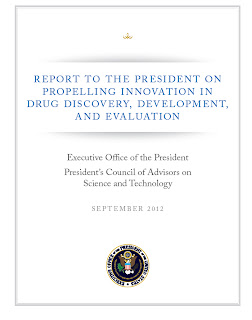by Margaret Anderson, Executive Director, FasterCures
 The President’s Council of Advisors on Science and Technology (PCAST) released its “Report to the President on Propelling Innovation in Drug Discovery, Development, and Evaluation” this week.
The President’s Council of Advisors on Science and Technology (PCAST) released its “Report to the President on Propelling Innovation in Drug Discovery, Development, and Evaluation” this week.
The punch line of the briefing came toward the end when
Steve Galson from Amgen opined that “There are rooms of reports on innovation
and the challenges – what will differentiate this one?” It was helpful to have
it said out loud, because I felt a sense of déjà vu listening to the presentations
and perspectives. Things may look tough now, but they’ll be much tougher if we
don’t wake up and smell the coffee.
- We heard about how innovation has played a huge role in advancing the health of our nation, but that the system is under stress.
- We heard about the key role the FDA plays in influencing the ecosystem’s behavior, but even with changes at the agency, more needs to be done.
- We heard about how collaboration is central to future discovery, but the system doesn’t consistently incent it.
- We heard about unmet need in the form of Alzheimer’s, treatment for psychiatric diseases, cancer, and heart disease and stroke, but that we have been making some inroads with treatments for diseases like HIV/AIDS.
- We heard about how the entire system is struggling for many reasons – funding, patent cliffs, low-hanging fruit being picked, and overall costs of drug development rising, but that there are byways being built.
- We heard how patients and venture philanthropy are central to solving the problem, but there aren’t groups in existence capable of taking on all the challenges.
- We heard there has been progress – at times breathtaking progress – but that there is still a long way to go to reap the benefit of the scientific promise that lies ahead.
- We heard how we need money to do all of this, but we don’t know exactly where it’s going to come from, especially in these tight times.
- And we heard we’d better get moving.
There is a shift underway; during the briefing we heard people like Todd Sherer,
who is the CEO of the Michael J. Fox Foundation for Parkinson’s Research, saying he’s optimistic
based on things he’s seeing. And Bob Beall, president and CEO of the Cystic Fibrosis Foundation,
talking about the game-changing approval of Kalydeco and the need to look at
the PCAST report with the express purpose of figuring out what recommendations
would speed things up. There was some discussion of consumers and patients
needing a seat at the table. Well, we learned doing our report “Back to Basics: HIV/AIDS Advocacy as a Model for Catalyzing Change” that you don’t get
handed a seat at the table, you earn it. And you earn it by getting smart about
the system and what solutions look like. I’d like to see us moving beyond
giving patients lip service to ensuring we’re having a real dialogue with them
about what they are already doing, and what is possible if and when they are
engaged. As Sherer reminded us, “patients want to be part of a solution.”
We know current resources are threatened by the possibility
of sequestration, which would automatically cut the federal budget in January
2013. Future resources to address these pressing needs would also be slashed.
The PCAST report cites two primary needs:
- better methodologies and tools to translate basic biological insights to validated therapeutic targets and leads, and
- the need to have a more efficient clinical trial system, as it currently constitutes 40 percent of the biopharmaceutical R&D budget.
It posits recommendations in areas of improving drug
discovery and development; improving drug evaluation; monitoring and
communication about benefits and risks; improving FDA management; and economic incentives.
There’s a timeframe for action and a list of steps to be taken. We need to
assess how this gets done, which entities can and should do it, in what
timeframe, and also look at what agencies like the FDA are already beginning to
do under the recently enacted PDUFA V agreement, and perhaps most importantly how
to get the resources to do it. We were probably all raised with the phrase
“money doesn’t grow on trees,” so we need to figure out creative ideas that
will focus attention on the imperative for funding.
By focusing on specific solutions and not just the
challenges, this report is different than many before it – but it can’t be put
on a shelf, action must be taken. As my husband often reminds me, “How do you
eat an elephant? One bite at a time.”

No comments:
Post a Comment